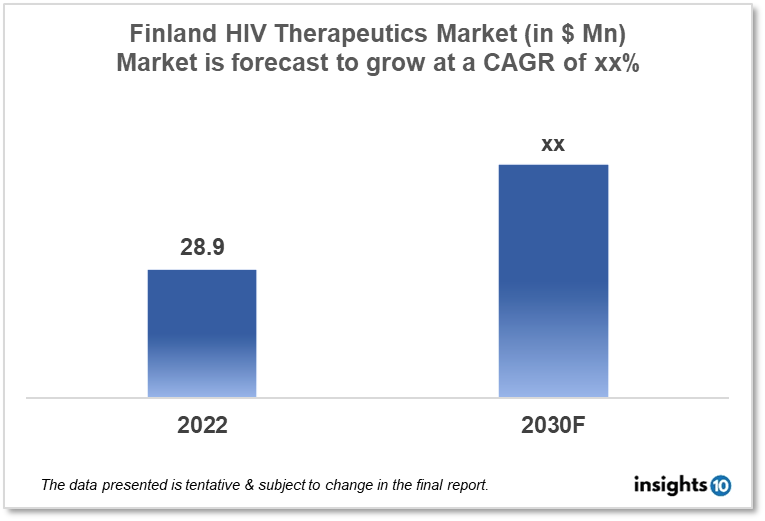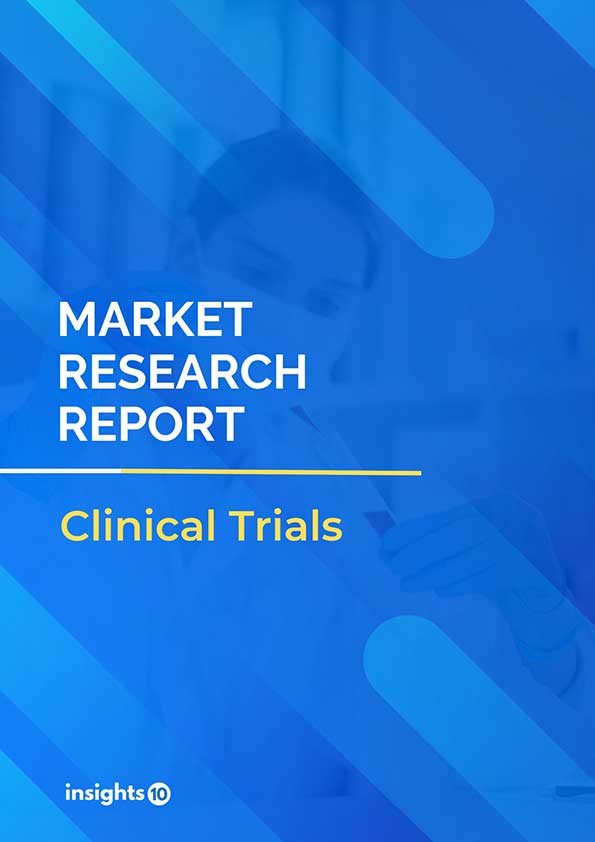Finland HIV Therapeutics Market Analysis
By 2030, it is anticipated that the Finland HIV therapeutics market will reach a value of $xx Mn from $28.9 Mn in 2022, growing at a CAGR of xx% during 2022-2030. The market is primarily dominated by local players such as Medivir, Abacus Medicine, and Orion Pharma. The market is driven by government policies, funding, and initiatives for the management of HIV infections in the country. The HIV therapeutics market in Finland is segmented by type, product, geography, end user, and distribution channel.
Buy Now

Finland HIV Therapeutics Market Analysis Summary
By 2030, it is anticipated that the Finland HIV therapeutics market will reach a value of $xx Mn from $28.9 Mn in 2022, growing at a CAGR of xx% during 2022-30.
Finland is a country in Northern Europe that shares borders with the Baltic Sea, the Gulf of Bothnia, and the Gulf of Finland. According to the most recent WHO data, HIV/AIDS-related deaths in Finland reached 100 in 2020. With an age-adjusted death rate of 0.08 per 100,000 people, Finland ranks 160th in the world. In 2020, Finland's adult HIV/AIDS prevalence was less than 0.1%, with 4000 HIV cases.
Finland has a national infectious diseases registry where laboratories and medical professionals report all new HIV cases to keep track of all new infections. The HIV Foundation/Finnish AIDS Council is a proactive HIV-related NGO in Finland. In Finland, HIV therapeutics are reimbursed through the national health insurance system which is managed by the Social Insurance Institution of Finland (Kela). Finland spent 9.6% of its GDP on healthcare in 2019.

Market Dynamics
Market Growth Drivers
Because of changing demographics in Finland and economic globalisation, the Finnish government is planning a Health, Social Services, and Regional Government reform. The reform aims to achieve full horizontal and vertical integration of primary and secondary levels of service in health and social care by forming larger units from service providers. The reform is expected to significantly alter the traditional structure of primary healthcare. The Ministry of Social Affairs and Health (STM) manages the preparation and implementation of Finland’s social welfare and healthcare policy. Furthermore, STM mandates and organises healthcare-related programmes and reforms. These factors will entice new entrants into the Finnish HIV therapeutics market.
Market Restraints
Although Finland has a low prevalence of HIV, there are still subpopulations affected by the virus, as well as some AIDS cases - but these are strongly linked to late diagnosis. Finland has a small HIV therapeutics market, which can limit the availability of newer, more expensive drugs. These factors may deter new entrants into the Finnish HIV therapeutics market.
Competitive Landscape
Key Players
- Orion Pharma (FIN)
- Abacus Medicine (FIN)
- Medivir (FIN)
- Gilead Sciences
- AbbVie
- Roche
Healthcare Regulations and Reimbursement Policies
The Finnish Medicines Agency (Fimea) regulates HIV therapeutics in Finland. Fimea is in charge of evaluating and approving new HIV drugs based on their safety, efficacy, and quality. HIV medications are considered prescription-only medications and must be administered by licenced pharmacies or healthcare facilities. Through the public healthcare system, the Finnish government provides free antiretroviral therapy to people living with HIV. Furthermore, Fimea continuously monitors the safety and effectiveness of HIV drugs and takes action to ensure that any safety concerns are addressed as soon as possible.
In Finland, HIV therapeutics are reimbursed through the national health insurance system, which is managed by the Social Insurance Institution of Finland (Kela). Kela is in charge of reimbursing eligible individuals, including those living with HIV, for the cost of antiretroviral therapy and other HIV medications. To be reimbursed, HIV medications must be on the national list of reimbursable medicines and prescribed by a licenced healthcare professional. In Finland, the reimbursement system for HIV therapeutics is divided into two levels. The government covers 100% of HIV drugs that are on the national list of reimbursable medicines in the first tier. Patients in the second tier may be required to pay a co-payment.
1. Executive Summary
1.1 Disease Overview
1.2 Global Scenario
1.3 Country Overview
1.4 Healthcare Scenario in Country
1.5 Patient Journey
1.6 Health Insurance Coverage in Country
1.7 Active Pharmaceutical Ingredient (API)
1.8 Recent Developments in the Country
2. Market Size and Forecasting
2.1 Epidemiology of Disease
2.2 Market Size (With Excel & Methodology)
2.3 Market Segmentation (Check all Segments in Segmentation Section)
3. Market Dynamics
3.1 Market Drivers
3.2 Market Restraints
4. Competitive Landscape
4.1 Major Market Share
4.2 Key Company Profile (Check all Companies in the Summary Section)
4.2.1 Company
4.2.1.1 Overview
4.2.1.2 Product Applications and Services
4.2.1.3 Recent Developments
4.2.1.4 Partnerships Ecosystem
4.2.1.5 Financials (Based on Availability)
5. Reimbursement Scenario
5.1 Reimbursement Regulation
5.2 Reimbursement Process for Diagnosis
5.3 Reimbursement Process for Treatment
6. Methodology and Scope
HIV Therapeutics Segmentation
By Types (Revenue, USD Billion):
- Nucleoside-Analog Reverse Transcriptase Inhibitors (NRTIs)
- Coreceptor Antagonists
- Entry and Fusion Inhibitors
- Integrase Inhibitors
- Protease Inhibitors (PIs)
- Non-Nucleoside Reverse Transcriptase Inhibitors (NNRTIs)
By Distribution Channel (Revenue, USD Billion):
- Hospital Pharmacies
- Retail Pharmacies
- Online Pharmacies
- Others
Methodology for Database Creation
Our database offers a comprehensive list of healthcare centers, meticulously curated to provide detailed information on a wide range of specialties and services. It includes top-tier hospitals, clinics, and diagnostic facilities across 30 countries and 24 specialties, ensuring users can find the healthcare services they need.
Additionally, we provide a comprehensive list of Key Opinion Leaders (KOLs) based on your requirements. Our curated list captures various crucial aspects of the KOLs, offering more than just general information. Whether you're looking to boost brand awareness, drive engagement, or launch a new product, our extensive list of KOLs ensures you have the right experts by your side. Covering 30 countries and 36 specialties, our database guarantees access to the best KOLs in the healthcare industry, supporting strategic decisions and enhancing your initiatives.
How Do We Get It?
Our database is created and maintained through a combination of secondary and primary research methodologies.
1. Secondary Research
With many years of experience in the healthcare field, we have our own rich proprietary data from various past projects. This historical data serves as the foundation for our database. Our continuous process of gathering data involves:
- Analyzing historical proprietary data collected from multiple projects.
- Regularly updating our existing data sets with new findings and trends.
- Ensuring data consistency and accuracy through rigorous validation processes.
With extensive experience in the field, we have developed a proprietary GenAI-based technology that is uniquely tailored to our organization. This advanced technology enables us to scan a wide array of relevant information sources across the internet. Our data-gathering process includes:
- Searching through academic conferences, published research, citations, and social media platforms
- Collecting and compiling diverse data to build a comprehensive and detailed database
- Continuously updating our database with new information to ensure its relevance and accuracy
2. Primary Research
To complement and validate our secondary data, we engage in primary research through local tie-ups and partnerships. This process involves:
- Collaborating with local healthcare providers, hospitals, and clinics to gather real-time data.
- Conducting surveys, interviews, and field studies to collect fresh data directly from the source.
- Continuously refreshing our database to ensure that the information remains current and reliable.
- Validating secondary data through cross-referencing with primary data to ensure accuracy and relevance.
Combining Secondary and Primary Research
By integrating both secondary and primary research methodologies, we ensure that our database is comprehensive, accurate, and up-to-date. The combined process involves:
- Merging historical data from secondary research with real-time data from primary research.
- Conducting thorough data validation and cleansing to remove inconsistencies and errors.
- Organizing data into a structured format that is easily accessible and usable for various applications.
- Continuously monitoring and updating the database to reflect the latest developments and trends in the healthcare field.
Through this meticulous process, we create a final database tailored to each region and domain within the healthcare industry. This approach ensures that our clients receive reliable and relevant data, empowering them to make informed decisions and drive innovation in their respective fields.
To request a free sample copy of this report, please complete the form below.
We value your inquiry and offer free customization with every report to fulfil your exact research needs.










































